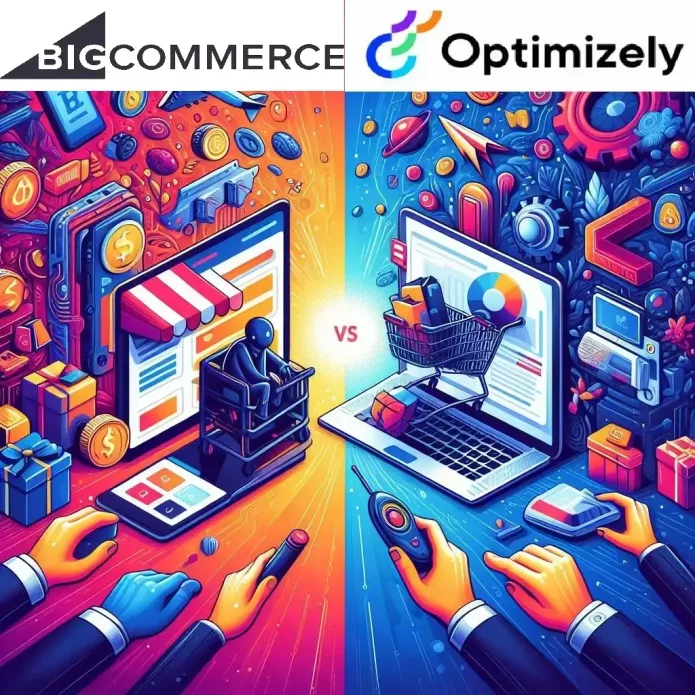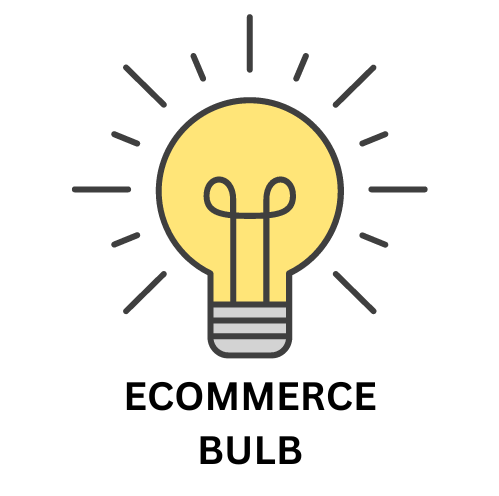In order to decide which ecommerce platform to use, BigCommerce vs Optimizely. A detailed comparison between features must be thoroughly done. If you want to decide which eCommerce platform to choose, there are many things to consider.
These are some examples of these factors:
- Cost.
- SEO friendliness.
- Page load speed.
- Canonical website URL.
- Indexing Control.
- Customizable HTML capabilities.
- Sitemap Generator.
- Integration with Google Analytics.
- Product Tagging and Categorization.
- Batch Uploading.
- Mobile Optimization.
- Built-in Blogging and Marketing Features.
- Social Sharing Buttons.
- Content Management Capabilities.
- Discount and promotion code tools.
- Easy to use Checkout.
- Reporting tools and custom reports.
- Integration of email marketing tools.
- Multiple payment options.
- Flexibility to add new eCommerce features.
- Exclusive features.
- Cons and pros.
Here we’ll discuss these factors to help you decide which platform is better for you, Optimizely or BigCommerce. And at the end of the discussion, we’ll recap and make a comparison for the scores of all these points to find out which eCommerce platform has the higher score, so that you’ll have a good view about both of them.
Pricing (BigCommerce vs Optimizely):

Choosing between BigCommerce and Optimizely for your online store depends heavily on your budget and the scale of your business. Here’s a comparison of their pricing structures:
BigCommerce:
- Pricing tiers: Based on annual sales volume, with four main tiers: Standard, Plus, Pro, and Enterprise.
- Monthly base fees: Start from $29.95 per month and increase with each tier, reaching $299.95 per month for Enterprise.
- Transaction fees: Additional fees apply to each transaction, ranging from 2.2% to 1.5% + $0.10, depending on your plan and payment gateway.
- Scalability: Higher tiers offer increased features and functionality for larger businesses.
Optimizely:
- Pricing models: Two main models: Performance-based (percentage of revenue) and Project-based (fixed fee).
- Performance-based pricing: Starts at 3% of monthly revenue, with discounts for higher revenue tiers.
- Project-based pricing: Varies depending on project scope and features needed.
- No transaction fees: Base prices include unlimited transactions.
- Scalability: Pricing adapts to your business growth through revenue-based or fixed-fee models.
Comparison:
- BigCommerce: More affordable for small businesses with lower sales volume due to fixed monthly fees. Transaction fees can add up with high sales. Good for businesses anticipating consistent growth due to tier upgrades.
- Optimizely: Can be more cost-effective for larger businesses with high revenue due to the percentage-based model. Project-based pricing offers predictability for specific needs. However, can be expensive for low-revenue businesses.
SEO Capabilities (BigCommerce vs Optimizely):

When it comes to SEO capabilities, both BigCommerce and Optimizely offer solid tools and features, but they cater to different needs and approaches. Here’s a breakdown:
BigCommerce:
- Strengths:
- Out-of-the-box SEO features like SEO-friendly URLs, meta descriptions, image alt tags, mobile responsiveness, and structured data.
- Integration with popular SEO tools like Google Search Console and Bing Webmaster Tools.
- Extensive app marketplace with numerous SEO-focused apps, including keyword research, technical SEO audits, and link building tools.
- Powerful developer resources for custom SEO implementations.
- Weaknesses:
- Limited built-in tools for content optimization and on-page SEO.
- Requires additional apps and manual effort for advanced SEO strategies.
- More complex for beginners to navigate SEO settings and optimization.
Optimizely:
- Strengths:
- Advanced A/B testing and personalization capabilities for optimizing page elements, content, and CTAs for better search engine results.
- AI-powered SEO recommendations and insights based on real-time data and user behavior.
- Integration with marketing automation tools for cross-channel optimization including SEO.
- Focus on experimentation and data-driven decision making for SEO improvements.
- Weaknesses:
- Fewer built-in SEO features compared to BigCommerce, lacking basic elements like meta descriptions and image alt tags.
- Requires technical expertise or developer involvement for setting up and utilizing SEO features effectively.
- Primarily focused on conversion optimization, with SEO as a secondary benefit.
Overall:
- BigCommerce: Ideal for businesses seeking a comprehensive SEO platform with built-in features, app integrations, and developer flexibility. Great for those comfortable with manual SEO optimization and technical knowledge.
- Optimizely: More suited for businesses interested in data-driven and experimental SEO through A/B testing and personalization. Requires technical expertise and focuses on optimizing conversions along with SEO.
Choosing the right platform depends on your priorities:
- If basic SEO features and app integrations are sufficient, BigCommerce might be more user-friendly and cost-effective.
- If advanced A/B testing, data-driven SEO insights, and conversion optimization are your primary goals, Optimizely could be a better fit.
PageLoad Speed (BigCommerce vs Optimizely):

Choosing between BigCommerce and Optimizely based on page load speed requires considering their different strengths and weaknesses. Here’s a breakdown:
BigCommerce:
- Strengths:
- Built-in features for image optimization, caching, and minification.
- CDN (Content Delivery Network) integration for faster global server response.
- App marketplace with numerous speed optimization apps.
- Developer access for custom speed improvements.
- Good baseline performance with optimization potential.
- Weaknesses:
- Out-of-the-box performance might not be as fast as highly optimized sites on other platforms.
- Some themes and apps can impact page load if not optimized.
- Requires technical knowledge for deeper performance optimization.
Optimizely:
- Strengths:
- Focus on experimentation and A/B testing, allowing data-driven optimization of page elements for speed.
- Integration with performance monitoring tools for identifying and resolving speed bottlenecks.
- Potential for significant speed improvements through targeted optimization based on data.
- Weaknesses:
- No built-in speed optimization features like caching or image optimization.
- Relies heavily on external tools and developer expertise for speed improvements.
- Base platform performance might not be inherently faster than BigCommerce.
Overall:
- BigCommerce: Offers a good baseline performance with built-in features and app integrations for easy optimization. Ideal for businesses looking for a user-friendly solution without extensive technical knowledge.
- Optimizely: Requires technical expertise and data-driven approach to achieve optimal page load speed. Can be highly effective for businesses willing to invest in performance optimization efforts and experimentation.
Choosing the right platform depends on your:
- Technical expertise: BigCommerce is more user-friendly for speed optimization, while Optimizely requires technical knowledge.
- Budget: BigCommerce offers affordable built-in features, while Optimizely might require additional tools and developer costs.
- Performance goals: Optimizely has the potential for significantly faster speeds through targeted optimization, while BigCommerce provides a solid baseline with room for improvement.
Canonical Website URL (BigCommerce vs Optimizely):

When it comes to canonical website URLs, both BigCommerce and Optimizely handle them differently, with each catering to distinct approaches:
BigCommerce:
- Strengths:
- Automatic canonical URL generation for product, category, and blog pages based on default settings.
- Fine-grained control over canonical URL settings through the platform interface.
- Plugin options for advanced canonicalization management and conflict resolution.
- More user-friendly for non-technical users to adjust basic canonical settings.
- Weaknesses:
- Limited automated detection and handling of duplicate content across different sections.
- Relies on manual input for some canonical URL configurations.
- Might require developer assistance for complex canonicalization rules and integrations.
Optimizely:
- Strengths:
- Focus on content optimization and experimentation empowers users to test different canonical URLs and measure their impact on performance.
- Integration with SEO tools can provide insights for identifying and resolving canonicalization issues.
- Developer-friendly platform allows for custom development of advanced canonicalization logic.
- Offers powerful tools for managing dynamic content and preventing duplicate URLs.
- Weaknesses:
- Lacks built-in automated canonical URL generation like BigCommerce.
- Requires technical expertise to set up and utilize canonicalization features effectively.
- Focus on experimentation might involve manual testing and adjustments for canonical URLs.
Overall:
- BigCommerce: Ideal for those seeking a user-friendly platform with basic automated canonicalization features and easy manual control. Suitable for non-technical users with straightforward canonicalization needs.
- Optimizely: More suited for tech-savvy users seeking advanced canonicalization control, experimentation, and data-driven optimization. Requires technical expertise and might involve manual configuration.
Indexing Control (BigCommerce vs Optimizely):

Both BigCommerce and Optimizely offer some control over indexing for your website, but with significant differences in capabilities and approach. Here’s a breakdown:
BigCommerce:
- Strengths:
- Built-in robots.txt editor allows direct control over which pages and files Googlebot can access.
- Meta robots tag options on individual pages for fine-grained control over indexing specific content.
- Integration with SEO tools that provide robots.txt optimization suggestions.
- User-friendly interface for non-technical users to manage basic indexing settings.
- Weaknesses:
- Limited ability to control indexing beyond robots.txt and meta robots tags.
- Lacks advanced crawling control or dynamic robots.txt generation features.
- Requires developer involvement for custom indexing rules and complex configurations.
Optimizely:
- Strengths:
- Focus on experimentation allows testing different robots.txt configurations and meta robots tags to see their impact on SEO.
- Integration with SEO tools can provide insights for identifying and optimizing indexing strategies.
- Developer-friendly platform allows for custom development of advanced indexing rules and functionalities.
- Offers dynamic robots.txt generation based on specific conditions and user behavior.
- Weaknesses:
- Lacks native robots.txt editor and meta robots tag options within the platform interface.
- Requires technical expertise to understand and utilize indexing control features effectively.
- Focus on experimentation might involve manual adjustments and testing for indexing configurations.
Overall:
- BigCommerce: Ideal for those seeking a user-friendly platform with basic indexing control through robots.txt and meta robots tags. Suitable for non-technical users with straightforward indexing needs.
- Optimizely: More suited for tech-savvy users seeking advanced indexing control, experimentation, and data-driven optimization. Requires technical expertise and might involve manual configuration and testing.

Customizable HTML Capabilities (BigCommerce vs Optimizely):

Both BigCommerce and Optimizely offer varying degrees of customization through HTML, but cater to different levels of technical expertise and specific needs. Here’s a breakdown:
BigCommerce:
- Strengths:
- Pre-designed templates with editable HTML sections allowing for basic visual and structural modifications.
- Theme code access for developers to directly edit HTML templates and inject custom code.
- App marketplace offering numerous theme and HTML-focused apps for extending functionality and design.
- Developer resources and documentation for building custom themes and functionalities.
- User-friendly interface with drag-and-drop options for non-technical users to customize some HTML elements.
- Weaknesses:
- Limited flexibility for deep HTML customization within pre-designed templates.
- Theme editing requires some coding knowledge or developer assistance for advanced changes.
- Some apps might override custom HTML code, requiring careful integration.
- Can be challenging for beginners with minimal HTML knowledge to fully utilize customization options.
Optimizely:
- Strengths:
- Built-in code editor for direct HTML manipulation within the platform interface.
- Templates built on front-end frameworks like React, allowing for greater flexibility and custom development.
- Focus on experimentation empowers testing different HTML changes and measuring their impact on user behavior.
- Developer-friendly platform with extensive documentation and APIs for building custom functionalities.
- Offers headless commerce capabilities for complete HTML control and integration with any front-end development framework.
- Weaknesses:
- Requires significant technical expertise and coding skills for effective HTML customization.
- Less user-friendly interface compared to BigCommerce for non-technical users.
- Focus on experimentation might involve frequent HTML changes and maintenance.
- Headless commerce requires advanced skills and resources for proper implementation.
Overall:
- BigCommerce: Ideal for those seeking a balance between user-friendly customization and deeper HTML control through theme editing and apps. Suitable for users with some coding knowledge or willing to hire developers for advanced changes.
- Optimizely: More suited for tech-savvy users and developers seeking complete control over HTML and front-end development. Requires significant technical expertise and resources for effective utilization.
Sitemap Generators (BigCommerce vs Optimizely):

When it comes to sitemap generators, both BigCommerce and Optimizely offer solutions, but cater to different needs and levels of technical expertise. Here’s a breakdown:
BigCommerce:
- Strengths:
- Built-in sitemap generator automatically creates and submits sitemaps to search engines.
- Flexible settings to exclude or prioritize specific pages within the sitemap.
- Integration with SEO tools provides insights for optimizing your sitemap for better crawling.
- User-friendly interface for non-technical users to manage basic sitemap settings.
- Weaknesses:
- Limited control over the sitemap structure and file format.
- Lacks advanced features like dynamic sitemap generation or pinging search engines for faster indexation.
- Customization requires developer involvement for modifying the generated sitemap file directly.
Optimizely:
- Strengths:
- Offers plugins and third-party integrations for various sitemap generators with more advanced features.
- Developer-friendly platform allows custom development of dynamic sitemaps based on specific rules and conditions.
- Integration with SEO tools can provide recommendations for optimizing sitemap content and structure.
- Offers more control over sitemap file format and submission options.
- Weaknesses:
- Relies on plugins or custom development for sitemap generation, requiring technical expertise.
- Less user-friendly compared to BigCommerce’s built-in solution for non-technical users.
- Might involve additional costs for premium sitemap generator plugins or development.
Overall:
- BigCommerce: Ideal for those seeking a user-friendly and straightforward sitemap generator with basic control and automatic submission. Suitable for non-technical users with standard sitemap needs.
- Optimizely: More suited for tech-savvy users and developers requiring advanced sitemap features, dynamic generation, and greater control over file format and submission. Requires technical expertise and might involve additional costs.
Integration With Google Analytics (BigCommerce vs Optimizely):

Both BigCommerce and Optimizely offer integrations with Google Analytics, but with slight differences in approach and features:
BigCommerce:
- Strengths:
- Built-in Google Analytics integration with automatic tracking code implementation.
- User-friendly interface for setting up basic tracking and goals.
- Integration with BigCommerce data allows for enhanced eCommerce reporting within Google Analytics.
- Large app marketplace with additional Google Analytics-related apps for deeper tracking and data visualization.
- Suitable for non-technical users or those wanting a straightforward integration.
- Weaknesses:
- Limited control over custom tracking configurations within the platform.
- Requires developer involvement for advanced tracking implementations and customizations.
- Might not offer complete data synchronization as readily as Optimizely.
Optimizely:
- Strengths:
- Highly customizable Google Analytics integration allows for advanced tracking configurations and event capturing.
- Developer-friendly API access for building custom integrations and data pipelines.
- Integrates with Optimizely’s experiment data for a holistic view of performance across platforms.
- Offers pre-built custom reports and dashboards for specific eCommerce tracking needs.
- More suitable for technically-savvy users or those needing advanced tracking and personalization strategies.
- Weaknesses:
- Requires technical expertise for setting up and utilizing advanced tracking features.
- Lacks a user-friendly interface for basic Google Analytics configuration compared to BigCommerce.
- Might involve additional costs for custom development or data integrations.
Product Tagging and Categorization (BigCommerce vs Optimizely):

When it comes to product tagging and categorization, both BigCommerce and Optimizely offer functionalities, but cater to different needs and approaches. Here’s a breakdown:
BigCommerce:
- Strengths:
- User-friendly interface for easy product tagging and category creation.
- Built-in tagging system with various types like product type, brand, size, color, etc.
- Support for unlimited categories and subcategories for detailed product organization.
- Integration with SEO tools for optimizing product tags and categories for search engines.
- Large app marketplace offering additional tagging and categorization tools for enhanced product discovery.
- Suitable for non-technical users and businesses with straightforward tagging needs.
- Weaknesses:
- Limited flexibility for creating and managing custom taxonomies beyond provided options.
- Lacks automation features for automatically assigning tags based on product attributes.
- Requires developer involvement for complex tagging rules and integration with external systems.
Optimizely:
- Strengths:
- Developer-friendly platform allowing for custom taxonomy creation and advanced product classification rules.
- Integration with personalization tools for dynamic product recommendations based on user behavior and tagging data.
- A/B testing capabilities for experimenting with different tagging and categorization strategies to optimize product discovery.
- API access for building custom integrations with external product information systems.
- More suited for technically-savvy users and businesses requiring complex tagging and dynamic product organization.
- Weaknesses:
- Requires technical expertise for creating and managing custom taxonomies and automation rules.
- Less user-friendly interface for basic product tagging and categorization compared to BigCommerce.
- Might involve additional costs for development or data integration needs.
Overall:
- BigCommerce: Ideal for those seeking a user-friendly system for basic product tagging, categorization, and SEO optimization. Suitable for non-technical users with straightforward needs.
- Optimizely: More suited for businesses requiring custom taxonomies, dynamic product recommendations, A/B testing, and deep integration with external systems. Requires technical expertise and might involve additional costs.
Batch Uploading (BigCommerce vs Optimizely):

When it comes to batch uploading products, both BigCommerce and Optimizely offer solutions, but with different levels of user-friendliness and functionalities:
BigCommerce:
- Strengths:
- Built-in CSV import tool for uploading multiple products at once.
- User-friendly interface for mapping CSV fields to product attributes and categories.
- Supports image importing along with product data in the CSV file.
- Integrates with various product data feed platforms for automated importing.
- Large app marketplace offering additional importing tools for specific data formats or functionalities.
- Suitable for non-technical users and businesses with occasional batch uploading needs.
- Weaknesses:
- Limited validation and mapping options for complex product data structures.
- Error handling and troubleshooting might be challenging for beginners.
- Requires manual preparation of CSV files in the correct format.
- Limited automation features for recurring product imports.
Optimizely:
- Strengths:
- Flexible API for programmatic product creation and importing from various data sources.
- Supports multiple data formats like CSV, XML, and JSON for import.
- Advanced validation and mapping capabilities for complex product data structures.
- Automation features for scheduling recurring product imports from any data source.
- Powerful error handling and logging for troubleshooting import issues.
- More suited for developers and businesses with frequent or complex product imports.
- Weaknesses:
- Requires technical expertise for API integration and data handling.
- Less user-friendly interface for manual CSV imports compared to BigCommerce.
- Might involve additional development costs for setting up and maintaining automated imports.
Overall:
- BigCommerce: Ideal for those seeking a user-friendly and straightforward CSV import tool for occasional product uploads. Suitable for non-technical users with basic needs.
- Optimizely: More suited for developers and businesses with frequent or complex product imports requiring automation, advanced data handling, and integration with external systems. Requires technical expertise and might involve additional costs.
Mobile Optimization (BigCommerce vs Optimizely):

When it comes to mobile optimization, both BigCommerce and Optimizely offer solutions, but cater to different approaches and levels of control. Here’s a breakdown:
BigCommerce:
- Strengths:
- Mobile-responsive themes designed to automatically adjust for different screen sizes.
- Built-in mobile previewing tool for testing your store’s appearance on various devices.
- Large app marketplace offering numerous mobile optimization apps for specific functionalities.
- User-friendly interface for non-technical users to manage basic mobile settings.
- Integrates with Google AMP for faster mobile page loading.
- Suitable for businesses with moderate mobile optimization needs.
- Weaknesses:
- Limited control over fine-tuning the mobile layout and experience beyond theme options.
- Requires developer involvement for advanced mobile customization or integration with custom functionalities.
- Mobile themes might not always be fully adaptable to specific brand requirements.
Optimizely:
- Strengths:
- Developer-friendly platform allowing for custom mobile development and complete control over the mobile experience.
- A/B testing capabilities for experimenting with different mobile layouts, features, and content to optimize conversions.
- Integration with personalization tools for dynamic content delivery based on user behavior and device type.
- Offers headless commerce options for complete control over the front-end mobile development using any framework.
- More suited for technically-savvy businesses seeking advanced mobile optimization and experimentation.
- Weaknesses:
- Requires significant technical expertise and development resources for building and maintaining custom mobile experiences.
- Less user-friendly for non-technical users compared to BigCommerce’s pre-built mobile themes.
- Might involve significant costs for development and ongoing maintenance of a custom mobile experience.
Overall:
- BigCommerce: Ideal for those seeking a user-friendly platform with mobile-responsive themes, basic adjustments, and app integrations for moderate mobile optimization needs. Suitable for businesses with limited development resources.
- Optimizely: More suited for businesses requiring complete control, A/B testing, personalization, and custom development for a highly optimized and dynamic mobile experience. Requires significant technical expertise and resources.
Built-in Blogging & Marketing Features (BigCommerce vs Optimizely):

When it comes to built-in blogging and marketing features, BigCommerce and Optimizely take different approaches, catering to diverse needs and skillsets:
BigCommerce:
- Strengths:
- Built-in blog engine with user-friendly interface for creating and managing blog posts.
- Basic SEO tools for optimizing blog content for search engines.
- Social media integration for easy sharing of blog posts across platforms.
- Email marketing features like email list management and basic campaign creation.
- Large app marketplace offering numerous integrations for advanced marketing automation and analytics.
- Suitable for beginners and businesses with basic blogging and marketing needs.
- Weaknesses:
- Limited design flexibility for blog layouts and branding customization.
- Lacks advanced content personalization and A/B testing capabilities for blog content.
- Email marketing features are basic and might require external tools for complex campaigns.
- Some features might require paid add-ons, increasing overall cost.
Optimizely:
- Strengths:
- Developer-friendly platform allowing for custom blog development and integration with any CMS or headless system.
- A/B testing capabilities for optimizing blog headlines, layouts, and calls to action for better engagement.
- Personalization tools for delivering dynamically tailored blog content based on user behavior and interests.
- Advanced reporting and analytics for insightful data on blog performance and audience engagement.
- Integrates with powerful marketing automation tools for complex campaigns and omnichannel marketing strategies.
- More suited for technically-savvy businesses and those requiring advanced blogging and marketing capabilities.
- Weaknesses:
- Requires technical expertise for building and maintaining a custom blog experience.
- Less user-friendly interface for beginners compared to BigCommerce’s built-in blog engine.
- Might involve significant development costs for creating and customizing a blog, especially for non-technical users.
- Requires integration with external email marketing tools for advanced campaign functionalities.
Overall:
- BigCommerce: Ideal for those seeking a user-friendly platform with built-in blogging and basic marketing features for straightforward content creation and campaign management. Suitable for beginners and businesses with limited technical resources.
- Optimizely: More suited for businesses requiring advanced blogging and marketing functionalities, A/B testing, personalization, and integration with external tools for a data-driven marketing approach. Requires technical expertise and might involve significant development and integration costs.
Social Sharing Buttons Availability (BigCommerce vs Optimizely):

Both BigCommerce and Optimizely offer options for adding social sharing buttons to your website, but with different approaches and levels of flexibility:
BigCommerce:
- Strengths:
- Built-in social sharing buttons for popular platforms like Facebook, Twitter, Pinterest, Instagram, etc.
- User-friendly interface for placing sharing buttons on product pages, blog posts, and other website elements.
- Integration with SEO tools like Google Search Console can provide insights on sharing performance.
- Large app marketplace offering additional social sharing plugins with expanded features and functionalities.
- Suitable for beginners and businesses needing basic social sharing functionality.
- Weaknesses:
- Limited customization options for the appearance and behavior of sharing buttons.
- Lacks advanced targeting and personalization features for social sharing based on user data.
- Some app integrations might require additional fees, increasing overall cost.
Optimizely:
- Strengths:
- Developer-friendly platform allowing for custom development of social sharing buttons with any desired features and functionalities.
- A/B testing capabilities for optimizing the placement, design, and behavior of social sharing buttons for better engagement.
- Integration with social analytics tools for detailed insights on sharing performance and user behavior.
- Offers headless commerce options for complete control over the front-end social sharing experience using any framework.
- More suited for technically-savvy businesses and those requiring advanced social sharing strategies and data analysis.
- Weaknesses:
- Requires technical expertise for building and maintaining custom social sharing buttons.
- Less user-friendly for non-technical users compared to BigCommerce’s built-in options.
- Might involve significant development costs for creating and customizing social sharing functionalities.
- Requires integration with external social analytics tools for detailed insights.
Overall:
- BigCommerce: Ideal for those seeking a user-friendly platform with built-in social sharing buttons for basic functionality and easy integration with popular platforms. Suitable for beginners and businesses with limited technical resources.
- Optimizely: More suited for businesses requiring advanced social sharing features, A/B testing, customization, detailed analytics, and integration with external tools for a data-driven social media strategy. Requires technical expertise and might involve significant development and integration costs.
Content Management Capabilities (BigCommerce vs Optimizely):

Choosing between BigCommerce and Optimizely for content management depends on your specific needs and technical expertise. Here’s a breakdown of their content management capabilities:
BigCommerce:
Strengths:
- User-friendly interface: Easy to create and manage product descriptions, blog posts, landing pages, and other content.
- Built-in WYSIWYG editor: Edit content visually without needing to code.
- Drag-and-drop page builder: Build custom-looking pages without needing technical knowledge.
- Content scheduling: Schedule content to be published at specific times.
- Mobile-friendly content: Content automatically adapts to different screen sizes.
- Large app marketplace: Offers numerous apps for extending content management functionalities.
Weaknesses:
- Limited flexibility: Design options are restricted by pre-built themes and page templates.
- Lacks advanced content personalization and A/B testing features.
- Not ideal for managing large and complex content structures.
- Some advanced features require paid add-ons, increasing overall cost.
Optimizely:
Strengths:
- Developer-friendly platform: Offers complete control over content management through custom development.
- Headless commerce capabilities: Integrate any front-end framework for complete creative freedom.
- A/B testing: Experiment with different content variants and layouts to optimize performance.
- Content personalization: Deliver dynamically tailored content based on user behavior and interests.
- Powerful reporting and analytics: Gain insights into content performance and user engagement.
- Suitable for managing large and complex content structures.
Weaknesses:
- Requires technical expertise: Not user-friendly for non-technical users.
- Steep learning curve: Mastering the platform can take time and effort.
- Significant development costs: Custom development and integrations can be expensive.
- Lacks built-in WYSIWYG editor and drag-and-drop functionality for beginners.
Overall:
- BigCommerce: Ideal for those seeking a user-friendly platform with built-in content management features for straightforward content creation and management. Suitable for beginners and businesses with limited technical resources.
- Optimizely: More suited for technically-savvy businesses and those requiring advanced content management capabilities, A/B testing, personalization, and full creative control. Requires significant technical expertise and might involve substantial development costs.
Discounts & Promotion Codes (BigCommerce vs Optimizely):

When it comes to discounts and promotion codes, both BigCommerce and Optimizely offer solutions, but cater to different approaches and levels of complexity:
BigCommerce:
- Strengths:
- Built-in coupon code functionality for creating and managing various discount types (percentage, fixed amount, free shipping).
- User-friendly interface for setting up and activating promotions with basic targeting options.
- Integration with marketing automation tools allows for more complex promotional campaigns.
- Large app marketplace offering numerous discount and promotion code plugins for additional features and functionalities.
- Suitable for beginners and businesses with straightforward promotional needs.
- Weaknesses:
- Limited targeting options for applying discounts based on customer segments or behavior.
- Lacks advanced promotion scheduling and dynamic coupon generation features.
- Limited reporting and analytics for analyzing the performance of your promotions.
- Some advanced features might require paid add-ons, increasing overall cost.
Optimizely:
- Strengths:
- Developer-friendly platform allowing for custom development of complex discount and promotion code functionalities.
- A/B testing capabilities for optimizing the effectiveness of different promotion types, coupon codes, and target audiences.
- Personalization tools enable dynamic discount offers based on individual customer attributes and behavior.
- Powerful reporting and analytics provide detailed insights into promotion performance and campaign effectiveness.
- Integrates with external marketing automation and CRM tools for comprehensive campaign management.
- More suited for technically-savvy businesses and those requiring advanced promotional strategies and data-driven optimization.
- Weaknesses:
- Requires technical expertise for building and maintaining custom promotion functionalities.
- Less user-friendly for non-technical users compared to BigCommerce’s built-in tools.
- Might involve significant development costs for creating and customizing advanced promotion features.
- Requires integration with external tools for advanced promotion management and analytics.
Overall:
- BigCommerce: Ideal for those seeking a user-friendly platform with built-in coupon code functionality and basic promotion management for straightforward discount campaigns. Suitable for beginners and businesses with limited technical resources.
- Optimizely: More suited for businesses requiring advanced promotion strategies, A/B testing, personalization, dynamic coupon generation, detailed analytics, and integration with external tools for a data-driven approach to discounts and promotions. Requires significant technical expertise and might involve substantial development and integration costs.
Easy to Use Checkout (BigCommerce vs Optimizely):

When it comes to user-friendliness of checkout systems, both BigCommerce and Optimizely have strengths and weaknesses, depending on your priorities and technical expertise:
BigCommerce:
Strengths:
- Highly user-friendly interface: Streamlined checkout process with minimal steps and clear instructions.
- Mobile-optimized checkout: Easy and convenient purchasing experience on all devices.
- Guest checkout option: Allows customers to buy without creating an account.
- Large app marketplace: Numerous extensions for adding features like one-page checkout, social logins, and abandoned cart recovery.
- Suitable for beginners and businesses with simple checkout needs.
Weaknesses:
- Limited customization options: Pre-designed checkout templates offer less flexibility for branding and personalization.
- Lacks advanced features like multi-step checkout with order summaries or dynamic coupon application.
- Limited data gathering capabilities for checkout analytics.
Optimizely:
Strengths:
- Developer-friendly platform: Highly customizable checkout experience with full control over design, functionality, and data collection.
- A/B testing capabilities: Optimize your checkout for faster completion rates and higher conversion rates.
- Dynamic checkout personalization: Tailor the checkout experience based on individual customer data and behavior.
- Integration with advanced analytics tools for detailed checkout performance insights.
- More suited for technically-savvy businesses and those requiring a fully optimized and personalized checkout experience.
Weaknesses:
- Requires technical expertise: Building and maintaining a custom checkout requires development skills.
- Less user-friendly interface compared to BigCommerce.
- Might involve significant development costs for creating and optimizing a custom checkout.
- Steeper learning curve for understanding and utilizing advanced features.
Overall:
- BigCommerce: Ideal for those seeking a simple, user-friendly checkout with mobile responsiveness and basic customization options. Suitable for beginners and businesses with uncomplicated checkout needs.
- Optimizely: More suited for businesses requiring a highly optimized, personalized, and A/B tested checkout experience with full control over data collection and advanced analytics. Requires technical expertise and might involve substantial development costs.
Reporting Tools and Custom Reports (BigCommerce vs Optimizely):

Both BigCommerce and Optimizely offer reporting tools, but with varying levels of detail, flexibility, and data manipulation capabilities. Here’s a breakdown:
BigCommerce:
Strengths:
- Built-in reports: Provide insights on sales, traffic, customers, marketing performance, and product details.
- User-friendly interface: Easy to understand and navigate even for non-technical users.
- Pre-built dashboards: Offer quick overviews of key performance indicators (KPIs).
- Basic custom report builder: Allows filtering and exporting data for simple data analysis.
- Integrations with marketing automation tools: Enhance reporting capabilities with additional data sources.
- Suitable for beginners and businesses with basic reporting needs.
Weaknesses:
- Limited data granularity: Reports might not provide detailed breakdowns of specific metrics.
- Limited customization options: Pre-built reports and dashboards offer less flexibility for tailoring to specific needs.
- Data manipulation capabilities are basic: Limited options for aggregating, grouping, and analyzing data beyond simple filters.
- Requires paid add-ons for advanced reporting features.
Optimizely:
Strengths:
- Highly customizable reports: Build reports with any available data point using a drag-and-drop interface.
- Advanced data manipulation: Aggregate, group, and analyze data with various functions and filters.
- Drill-down capabilities: Analyze data at different levels for deeper insights.
- Custom dashboards: Create personalized dashboards with specific KPIs and visualizations.
- A/B testing data integration: Analyze A/B testing results alongside other performance data.
- More suited for technically-savvy users and businesses requiring in-depth data analysis and custom reporting.
Weaknesses:
- Requires technical expertise: Building and customizing reports requires understanding data and the platform’s functionalities.
- Less user-friendly interface compared to BigCommerce’s pre-built reports.
- Might involve development costs for building complex custom reports and dashboards.
- Requires integration with external tools for advanced data visualization and analysis.
Overall:
- BigCommerce: Ideal for those seeking user-friendly built-in reports and basic data analysis with pre-built dashboards and integrations for general performance insights. Suitable for beginners and businesses with straightforward reporting needs.
- Optimizely: More suited for businesses requiring highly customized reports, advanced data manipulation, A/B testing analysis, personalized dashboards, and integration with external tools for in-depth data analysis and custom reporting. Requires technical expertise and might involve additional costs.
Integration of Email Marketing Tools (BigCommerce vs Optimizely):

When it comes to email marketing tool integration, both BigCommerce and Optimizely offer solutions, but cater to different needs and levels of technical expertise:
BigCommerce:
Strengths:
- Built-in email marketing features: Includes basic functionalities like email list management, campaign creation, and basic analytics.
- Large app marketplace: Offers numerous integrations with popular email marketing platforms like Mailchimp, Klaviyo, and ActiveCampaign.
- User-friendly interface: Easy to set up and manage integrations even for non-technical users.
- Suitable for beginners and businesses with basic email marketing needs.
Weaknesses:
- Limited functionality: Built-in email marketing features are basic and lack advanced automation capabilities.
- Data synchronization might be less efficient compared to dedicated email marketing platforms.
- Requires paid subscriptions for specific email marketing apps in the marketplace.
Optimizely:
Strengths:
- API access: Allows for custom integrations with any email marketing platform through code.
- Supports complex automation workflows and data exchange between Optimizely and email marketing platforms.
- Offers advanced personalization features for tailoring email campaigns based on user data and behavior.
- Integrates with powerful analytics tools for detailed campaign performance insights.
- More suited for technically-savvy businesses and those requiring advanced email marketing strategies and data-driven personalization.
Weaknesses:
- Requires technical expertise for setting up and managing custom integrations.
- Less user-friendly compared to BigCommerce’s pre-built integrations.
- Might involve development costs for building and maintaining custom integrations.
Overall:
- BigCommerce: Ideal for those seeking a user-friendly platform with basic built-in email marketing features and convenient integrations with popular email marketing platforms for straightforward campaigns. Suitable for beginners and businesses with limited technical resources.
- Optimizely: More suited for businesses requiring advanced email marketing automation, personalization, sophisticated data exchange, and custom integrations with any email marketing platform for a fully data-driven and flexible approach. Requires technical expertise and might involve significant development costs.
Multiple Payment Options (BigCommerce vs Optimizely):

Both BigCommerce and Optimizely offer multiple payment options for merchants, but cater to different preferences and technical expertise:
BigCommerce:
Strengths:
- Built-in payment gateways: Includes popular options like PayPal, Stripe, Amazon Pay, Apple Pay, and Google Pay.
- Large app marketplace: Offers numerous integrations with additional payment gateways and alternative payment methods like cryptocurrency or buy now, pay later.
- User-friendly interface: Easy to set up and manage payment options even for non-technical users.
- Transparent pricing: No hidden fees for using built-in gateways.
- Suitable for beginners and businesses with straightforward payment needs.
Weaknesses:
- Limited customization: Pre-built integrations might not offer full control over the payment experience.
- Fewer advanced features: Lacks fraud prevention tools or recurring billing functionalities for some gateways.
- Transaction fees might be higher than Optimizely for certain payment processors.
Optimizely:
Strengths:
- API access: Allows for custom integration with any payment processor or gateway through code.
- Supports complex payment workflows and customization of the payment experience.
- Advanced fraud prevention features: Integrates with fraud detection tools for enhanced security.
- Recurring billing functionalities: Suitable for subscriptions and memberships.
- Potentially lower transaction fees: Can negotiate directly with payment processors for competitive rates.
- More suited for technically-savvy businesses and those requiring advanced payment functionalities and custom integrations.
Weaknesses:
- Requires technical expertise: Building and maintaining custom integrations is not user-friendly for non-technical users.
- Might involve development costs for setting up and managing custom integrations.
- Requires research and selection of suitable payment processors for specific needs.
Overall:
- BigCommerce: Ideal for those seeking a user-friendly platform with built-in popular payment gateways, convenient integrations with additional options, and transparent pricing for straightforward payment processing. Suitable for beginners and businesses with limited technical resources.
- Optimizely: More suited for businesses requiring advanced payment functionalities, custom integrations, flexible payment workflows, advanced fraud prevention, recurring billing, and potentially lower transaction fees. Requires technical expertise and might involve significant development costs.
Flexibility to Add New eCommerce Features (BigCommerce vs Optimizely):

Choosing between BigCommerce and Optimizely for flexibility in adding new eCommerce features depends on your technical expertise, budget, and desired level of control:
BigCommerce:
Strengths:
- Large app marketplace: Offers a plethora of apps and plugins for extending functionality with new features like loyalty programs, gift cards, subscriptions, reviews, personalized recommendations, and more.
- User-friendly interface: Easy to install and manage apps even for non-technical users.
- No coding required: Most apps work seamlessly through drag-and-drop or configuration settings.
- Suitable for beginners and businesses with simple integration needs.
Weaknesses:
- Limited customization: Apps provide pre-built features and might not offer complete control over functionality.
- Subscription fees: Many apps require monthly or annual subscriptions, adding to your overall cost.
- Compatibility issues: Potential for conflicts between different apps depending on their functionalities.
Optimizely:
Strengths:
- API access: Offers full flexibility to build custom features and functionalities through coding.
- Headless commerce capabilities: Integrate any front-end framework for complete creative control over your eCommerce experience.
- Integrations with external tools: Expand functionalities by connecting with marketing automation platforms, CRM systems, and other tools.
- More suited for technically-savvy businesses and those requiring unique and highly customized features.
Weaknesses:
- Requires technical expertise: Building and maintaining custom features and integrations is not user-friendly for non-technical users.
- Development costs: Custom development can be expensive, depending on the complexity of the feature.
- Steeper learning curve: Understanding APIs and integrating external tools requires technical knowledge.
Overall:
- BigCommerce: Ideal for those seeking user-friendly and affordable app integrations for adding standard eCommerce features without the need for coding. Suitable for beginners and businesses with limited technical resources.
- Optimizely: More suited for businesses requiring unique and highly customized features, full control over the front-end experience, and integration with external tools for a highly flexible and data-driven approach. Requires significant technical expertise and might involve substantial development costs.
Exclusive Features (BigCommerce vs Optimizely):

While both BigCommerce and Optimizely offer rich feature sets, each platform boasts some “exclusive” functionalities that might sway your decision depending on your specific needs:
BigCommerce:
- Built-in visual merchandising tools: Drag-and-drop page builder, product filters, and content blocks for easy store customization without coding.
- ChannelAdvisor integration: Streamlines multi-channel selling by unifying inventory management, order fulfillment, and reporting across various sales channels.
- BigCommerce Retail: Brick-and-mortar integration enables omnichannel commerce by connecting your online store with physical stores for inventory visibility, in-store pickup, and BOPIS (buy online, pick up in-store).
- Built-in SEO tools: Keyword research, sitemap generation, and meta tag optimization to improve organic search visibility.
- Large app marketplace: Over 1,600 apps and plugins extend functionality with features like loyalty programs, subscriptions, and personalized recommendations.
Optimizely:
- Headless commerce capabilities: Offers APIs and SDKs for complete control over the front-end development and integration with any framework like React or Vue.js.
- A/B testing and personalization: Experiment with different website elements and content variations to optimize user experience and conversions.
- Advanced analytics and reporting: Detailed insights into customer behavior, campaign performance, and A/B testing results for data-driven decision making.
- Integrations with powerful marketing automation and CRM tools: Streamline customer journeys and personalize marketing campaigns based on rich customer data.
- Developer-friendly platform: Provides APIs, custom events, and webhooks for advanced integrations and building bespoke features.
Choosing the right platform depends on your priorities:
- For visual merchandising and ease of use: BigCommerce’s built-in tools and large app marketplace make it a good choice.
- For multi-channel selling: BigCommerce’s ChannelAdvisor integration offers a seamless solution.
- For omnichannel commerce: BigCommerce Retail simplifies brick-and-mortar integration.
- For SEO: BigCommerce’s built-in tools provide a good starting point.
- For developer flexibility and control: Optimizely’s headless commerce and API tools cater to advanced needs.
- For A/B testing and personalization: Optimizely excels in data-driven optimization and user experience experimentation.
- For complex marketing automation and integrations: Optimizely connects seamlessly with powerful external tools.
Ultimately, the most “exclusive” feature is the one that best addresses your specific requirements and enhances your eCommerce growth strategy. Analyze your needs, technical expertise, and budget to make an informed decision.
Market Share (BigCommerce vs Optimizely):

While both BigCommerce and Optimizely offer compelling features for eCommerce, their market share and focus differ significantly. Here’s a breakdown:
Market Share:
- BigCommerce: Holds a larger market share in the eCommerce platform category, estimated at around 1.00% based on SimilarTech data. This translates to a larger user base and potentially more community resources and integration options.
- Optimizely: Falls outside the top 16 eCommerce platforms in the same data set, indicating a smaller market share with a more niche focus. However, it maintains a strong presence in the broader development tools category with around 1.22% market share.
Focus:
- BigCommerce: Primarily caters to established and growing eCommerce businesses seeking a user-friendly platform with built-in features, app integrations, and marketing tools for straightforward website management and sales growth.
- Optimizely: Targets technically-savvy businesses and development teams requiring advanced control, customization, A/B testing, personalization, and data-driven optimization through APIs and integrations with external tools. While it can handle eCommerce, its emphasis is on broader website optimization and experimentation.
Cons Of (BigCommerce vs Optimizely):

What are the DrawBacks of BigCommerce vs Optimizely – Downsides Of (BigCommerce vs Optimizely)
Choosing the right eCommerce platform involves not only understanding their strengths but also acknowledging their potential drawbacks. Here’s a breakdown of the key weaknesses you might encounter in BigCommerce and Optimizely:
BigCommerce:
- Limited customization: While user-friendly, BigCommerce’s pre-built themes and page templates offer less flexibility for highly customized store design.
- App reliance: Many advanced features require paid app integrations, increasing overall costs and potentially introducing compatibility issues.
- Limited control over front-end development: BigCommerce lacks the headless commerce capabilities of Optimizely, making it less suitable for developers seeking complete front-end control.
- Less data-driven: Built-in reporting tools, while convenient, are not as detailed as Optimizely’s advanced analytics and A/B testing capabilities for data-driven decision making.
- Higher transaction fees for certain payment processors compared to Optimizely.
Optimizely:
- Steeper learning curve: Requires technical expertise to utilize the platform’s full potential, including building custom functionalities and integrations.
- Development costs: Custom development and integration with external tools can be expensive, especially for complex needs.
- Not user-friendly for beginners: The API-based approach and developer-centric tools might overwhelm non-technical users.
- Limited built-in features: Lacks some readily available functionalities compared to BigCommerce’s extensive app marketplace, requiring more development effort.
- Not strictly an eCommerce platform: While capable of handling eCommerce, Optimizely’s broader focus on website optimization and experimentation might not cater specifically to all eCommerce needs.
Hidden Charges / Cost & Fees (BigCommerce vs Optimizely):

Transparency in pricing is crucial for choosing the right eCommerce platform. While both BigCommerce and Optimizely offer clear base pricing plans, it’s essential to be aware of potential hidden charges or fees that can creep into your budget:
BigCommerce:
- Transaction fees: Additional fees charged on top of your payment processor’s rates, ranging from 0.5% to 2% depending on your plan.
- App costs: Many features require paid app integrations, with monthly or annual subscriptions adding to your overall expense.
- Theme costs: Premium themes can be expensive, especially if you desire advanced customization.
- Data storage fees: Exceeding your plan’s storage limit can incur additional charges.
- Developer costs: If you require custom development beyond app integrations, you’ll need to factor in development fees.
Optimizely:
- Integration fees: Connecting to specific external tools might involve additional charges depending on the chosen tool and plan.
- Development costs: Custom features, integrations, and advanced data analysis often require developer input, leading to hourly or project-based fees.
- API usage fees: Extensive API usage beyond your plan’s allowance can result in additional charges.
- Headless commerce costs: Building and maintaining a custom front-end for headless commerce requires ongoing development and infrastructure costs.
- External tool subscriptions: Integrating with powerful marketing automation or CRM tools might incur separate subscription fees.
What are the Fortes of eCommerce Platforms (BigCommerce vs Optimizely)?
Choosing the right eCommerce platform depends on your specific needs and priorities. Both BigCommerce and Optimizely offer strengths in different areas, so understanding their fortes can help you make an informed decision:
Strengths of BigCommerce:
- User-friendly: BigCommerce’s interface is intuitive and easy to navigate, making it ideal for beginners and non-technical users.
- Built-in features: BigCommerce offers a wide range of built-in features, including product management, content management, SEO tools, marketing automation, and analytics, minimizing the need for additional integrations.
- Large app marketplace: BigCommerce’s extensive app marketplace offers thousands of apps and plugins that can extend its functionality, catering to a wide variety of eCommerce needs.
- Affordable pricing: BigCommerce offers transparent pricing plans with no hidden fees.
- Mobile-friendly: BigCommerce websites are automatically optimized for mobile devices, ensuring a seamless user experience on all platforms.
- Multi-channel selling: BigCommerce integrates with popular marketplaces and sales channels, enabling you to sell your products across multiple platforms.
Strengths of Optimizely:
- Developer-friendly: Optimizely provides APIs and SDKs that give developers complete control over the front-end development and integrations with any framework.
- Headless commerce: Optimizely’s headless commerce capabilities allow you to build a completely custom front-end experience, giving you ultimate flexibility and control.
- A/B testing and personalization: Optimizely excels in A/B testing and personalization, allowing you to experiment with different website elements and content variations to optimize user experience and conversions.
- Advanced analytics and reporting: Optimizely provides detailed insights into customer behavior, campaign performance, and A/B testing results, empowering you to make data-driven decisions.
- Integrations with powerful tools: Optimizely integrates with advanced marketing automation, CRM, and analytics tools, giving you access to a vast array of data and capabilities.
- Scalability: Optimizely’s flexible architecture can be easily scaled to accommodate your business growth.
Conclusion (Comparison Table for BigCommerce vs Optimizely):
As we can see from the detailed comparison between these two platforms (Optimizely vs BigCommerce) that the overall score for Optimizely is better than BigCommerce’s.
- BigCommerce thrives in scalability, app integrations, developer flexibility, and marketing automation. It’s ideal for businesses with ambitious growth plans and complex needs.
- While Optimizely excels in these fields:
- Flexibility and control for developers
- Headless commerce capabilities for unique experiences
- Data-driven optimization through A/B testing and personalization
- Powerful analytics and reporting for informed decision-making
- Integration with advanced marketing and analytics tools
- Scalability to accommodate business growth
Note that the comparison was done with eCommerce and online business in mind.
I hope this could give you the required insight to choose which eCommerce Platform to use for your future projects!
Here is the full comparison, Optimizely vs BigCommerce Review in easy to comprehend bullet points:
| eCommerce Platform | Optimizely | BigCommerce |
|---|---|---|
| Price | 7.8 | 8.0 |
| SEO Friendliness | 8.2 | 8.5 |
| Page Load Speed | 7.0 | 7.0 |
| Canonical Website URL | 9.1 | 9.0 |
| Indexing Control | 9.1 | 9.0 |
| Customizable HTML capabilities | 9.2 | 9.0 |
| Sitemap Generator | 8.5 | 8.5 |
| Integration With Google Analytics | 9.0 | 8.5 |
| Product Tagging & Categorization | 8.5 | 8.0 |
| Batch Uploading | 7.8 | 7.5 |
| Mobile Optimization | 8.8 | 8.5 |
| Built-in Blogging & Marketing Features | 9.3 | 9.0 |
| Social Sharing Buttons | 9.2 | 9.0 |
| Content Management Capabilities | 8.7 | 8.5 |
| Discount & Promo Code Tools | 9.3 | 9.0 |
| Easy to Use Checkout | 8.5 | 8.0 |
| Reporting Tools & Custom Reports | 9.7 | 9.5 |
| Integration of Email Marketing Tools | 8.9 | 8.0 |
| Multiple Payment Options | 9.4 | 9.5 |
| Flexibility to Add New eCommerce Features | 8.6 | 9.0 |
| Exclusive Features | 9.0 | 9.0 |
| Market Share | 5.0 | 6.0 |
| CONS & PROS | 8.0 | 8.5 |
| Forte | 8.0 | 8.0 |
| Hidden Fees & Charges | 7.0 | 7.0 |
| Overall Assessment (Average) | 8.5 | 8.4 |


Leave a Reply